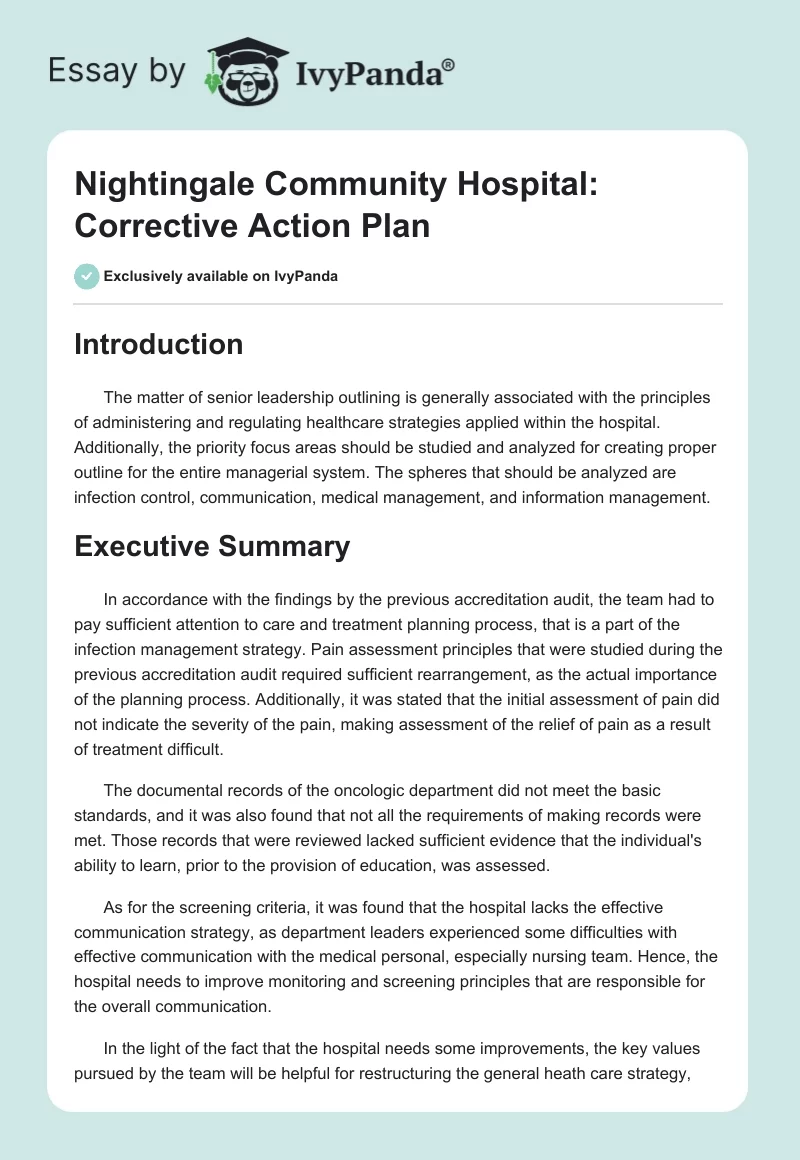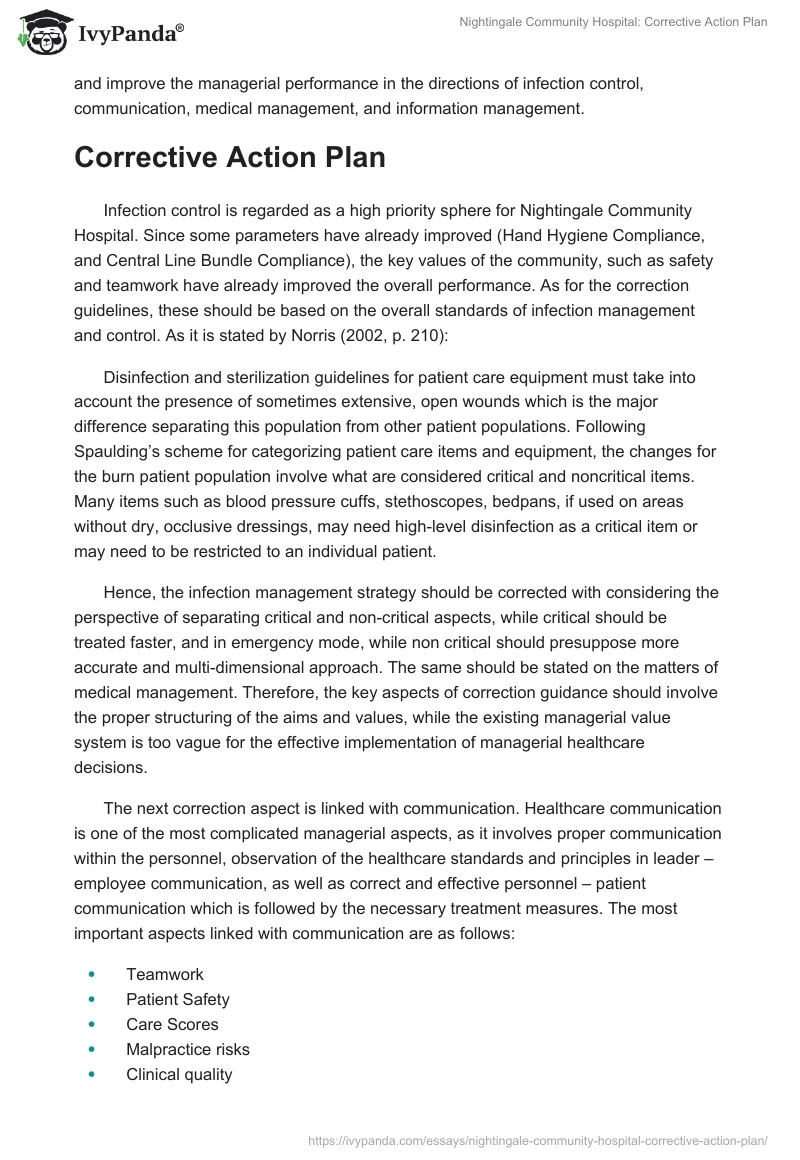Introduction
The matter of senior leadership outlining is generally associated with the principles of administering and regulating healthcare strategies applied within the hospital. Additionally, the priority focus areas should be studied and analyzed for creating proper outline for the entire managerial system. The spheres that should be analyzed are infection control, communication, medical management, and information management.
Executive Summary
In accordance with the findings by the previous accreditation audit, the team had to pay sufficient attention to care and treatment planning process, that is a part of the infection management strategy. Pain assessment principles that were studied during the previous accreditation audit required sufficient rearrangement, as the actual importance of the planning process. Additionally, it was stated that the initial assessment of pain did not indicate the severity of the pain, making assessment of the relief of pain as a result of treatment difficult.
The documental records of the oncologic department did not meet the basic standards, and it was also found that not all the requirements of making records were met. Those records that were reviewed lacked sufficient evidence that the individual’s ability to learn, prior to the provision of education, was assessed.
As for the screening criteria, it was found that the hospital lacks the effective communication strategy, as department leaders experienced some difficulties with effective communication with the medical personal, especially nursing team. Hence, the hospital needs to improve monitoring and screening principles that are responsible for the overall communication.
In the light of the fact that the hospital needs some improvements, the key values pursued by the team will be helpful for restructuring the general heath care strategy, and improve the managerial performance in the directions of infection control, communication, medical management, and information management.
Corrective Action Plan
Infection control is regarded as a high priority sphere for Nightingale Community Hospital. Since some parameters have already improved (Hand Hygiene Compliance, and Central Line Bundle Compliance), the key values of the community, such as safety and teamwork have already improved the overall performance. As for the correction guidelines, these should be based on the overall standards of infection management and control. As it is stated by Norris (2002, p. 210):
Disinfection and sterilization guidelines for patient care equipment must take into account the presence of sometimes extensive, open wounds which is the major difference separating this population from other patient populations. Following Spaulding’s scheme for categorizing patient care items and equipment, the changes for the burn patient population involve what are considered critical and noncritical items. Many items such as blood pressure cuffs, stethoscopes, bedpans, if used on areas without dry, occlusive dressings, may need high-level disinfection as a critical item or may need to be restricted to an individual patient.
Hence, the infection management strategy should be corrected with considering the perspective of separating critical and non-critical aspects, while critical should be treated faster, and in emergency mode, while non critical should presuppose more accurate and multi-dimensional approach. The same should be stated on the matters of medical management. Therefore, the key aspects of correction guidance should involve the proper structuring of the aims and values, while the existing managerial value system is too vague for the effective implementation of managerial healthcare decisions.
The next correction aspect is linked with communication. Healthcare communication is one of the most complicated managerial aspects, as it involves proper communication within the personnel, observation of the healthcare standards and principles in leader – employee communication, as well as correct and effective personnel – patient communication which is followed by the necessary treatment measures. The most important aspects linked with communication are as follows:
- Teamwork
- Patient Safety
- Care Scores
- Malpractice risks
- Clinical quality
- Accreditation (Shi, 2007)
The correction plan for this managerial aspect should be based on the ten simple rules of healthcare communication offered by the IOM. In short, these rules presuppose the increased communication, and, as a consequence, treatment quality. A patient should get help and assistance whenever he/she is located, and at anytime. The overall care system should be designed for providing instant reaction for the basic needs, and operative solution of non-standard requirements. Additionally, this should involve infection control, and information management. Otherwise, the flexibility of the communication system will be endangered. The IOM’s rules also involve the necessity to guarantee the access to medical information for patients. However, there is a necessity to offer the necessary support for patients if the information is not encouraging. The most complicated aspect of healthcare communication involves care based on scientific knowledge. This also means that the information should be easily interpretable for every team member.
Information Management correction mainly requires assessment and correction of the decision making system. In general, the mistakes reported by the accreditation audit restrict the effectiveness of the current decision making policy. Nevertheless, it should be emphasized that technologic aspects of information management are not involved into the correction plan, as the hospital management needs to improve the overall informational flow. This means that the actual importance of the mistakes noted will be explained by the opportunity to define the key correction actions. These are the necessity to create a unified data basis that will be use by medical personnel for communication, and storing medical records. Additionally, this will be useful for improving the quality of records, and the quality of communication. (King, 2001)
Justification
The selected correction guidelines are needed for the proper arrangement of the managerial practices in healthcare. The defined improvement directions are needed for creating proper communication, information, and medical management strategies. Since the outlined improvements are needed for the overall managerial performance, the key improvements that are expected after these implementations are linked with reducing barriers for communication development, as well as for improving the overall atmosphere within the team. Moreover, if the managerial aspect of communication regulation is properly adjusted, the healthcare principles will be improved, as the community will be able to observe most of the communicational rules from the IOM’s requirements. In the light of this fact, it should be stated that regardless of the accreditation audit results, the hospital will acquire additional potential for growth and development. Since the involvement of the managerial principles into the healthcare sphere is needed for the effective regulation of the communication process, the medical experts also require the set of rules that will regulate their medical practice.
Conclusion
The corrective action plan for the Nightingale community Hospital is based on the necessity to improve the overall healthcare performance of the hospital. The improvements are based on the ten IOM’s rules, as well as on the proper analysis of the accreditation audit results.
Reference List
King, H., A. (2001) The Primary Health Care Strategy. New York: Oxford University Press.
Norris, A.C. (2002). Current Trends and Challenges in Health Communication, Health Informatics Journal, Vol. 8, No. 4, pp. 205-213
Shi L. (2007). Health Care Spending, Delivery, and Outcome in Developed Countries: a Cross-National Comparison. American Journal of Medical Quality 12:2 83–93.


